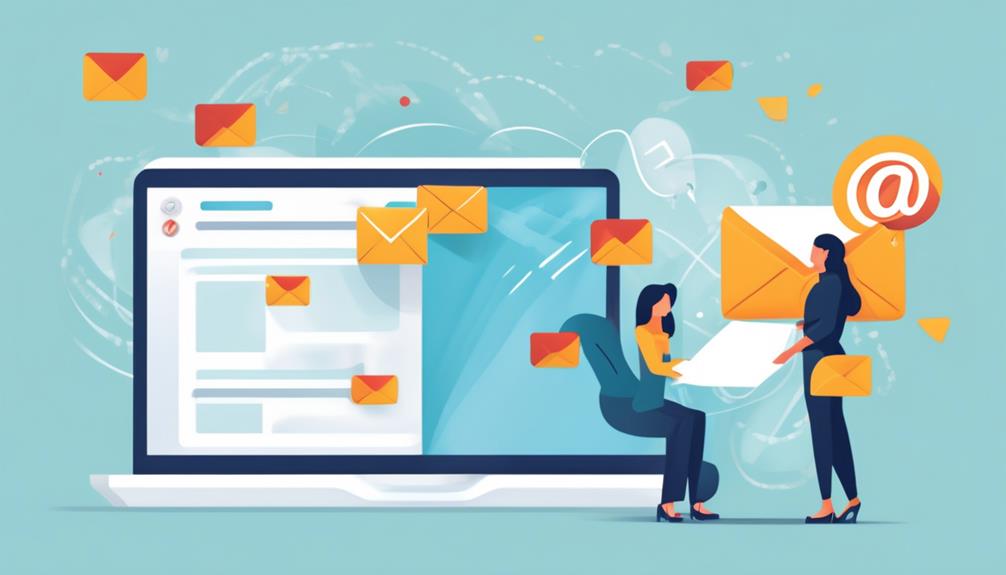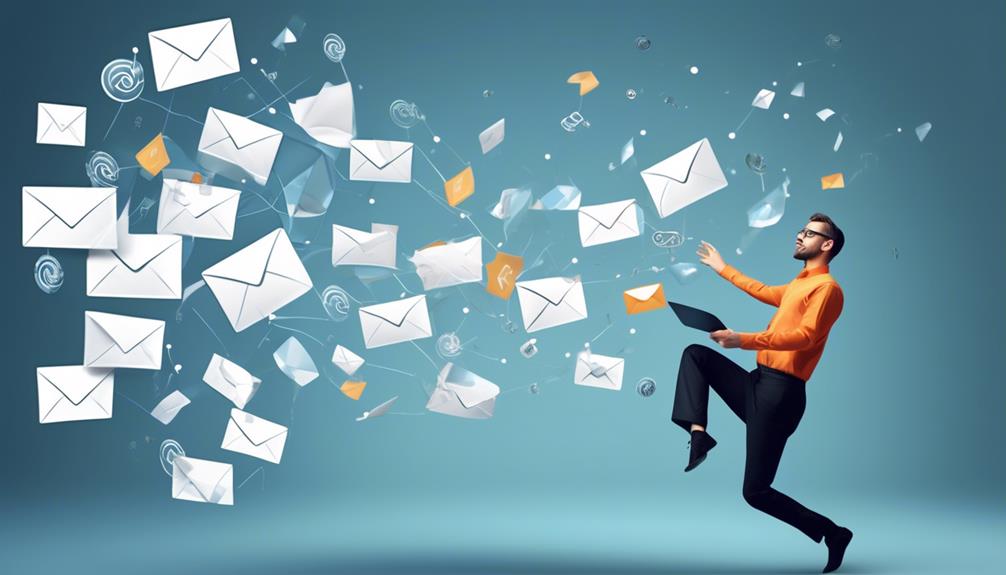Is email marketing difficult?
Many people wonder about the difficulty of email marketing, and it's a valid question. The landscape of digital marketing is ever-evolving, and email marketing is no exception. However, with the right strategies and tools, navigating through the complexities of email marketing can be more manageable than one might think.
There are key insights and practical tips that can help us understand and master this form of marketing, making it an essential skill for any modern marketer.
Key Takeaways
- Email marketing requires a strategic approach, attention to detail, and continuous optimization.
- It is not just about promotions, but also about building and nurturing relationships.
- Success in email marketing is not guaranteed without effort and proper strategies.
- Personalization, segmentation, and automation are key techniques for success.
Understanding Email Marketing
Understanding Email Marketing involves mastering the art of connecting with your audience through strategic communication and targeted content delivery. It's crucial to navigate the complexities of email marketing to avoid common mistakes and achieve success. A/B testing, design, content, simplicity, and storytelling are all critical aspects to focus on.
By honing these key areas, we can sidestep the pitfalls that many encounter in their email marketing endeavors. Additionally, the importance of segmentation can't be overstated. Demographics, behavior, dates, purchase history, and engagement levels all play a pivotal role in effectively segmenting your email list for maximum impact.
Furthermore, personalization is a powerful tool in the arsenal of any email marketer. Personalized subject lines, timing, customized content, dynamic tags, and the creative use of emojis/GIFs all contribute to enhancing the personal connection with your audience.
Common Misconceptions

Navigating the complexities of email marketing can lead to misconceptions that hinder success. It's essential to address common email marketing misconceptions to pave the way for successful email campaigns. Here are some misconceptions to avoid:
- Email marketing is easy: Contrary to popular belief, successful email marketing requires a strategic approach, attention to detail, and continuous optimization. It's not just about sending out mass emails; it's about crafting personalized, engaging content that resonates with recipients.
- Email marketing is only about promotions: While promotions can be a part of email marketing, it's not the only focus. Building and nurturing relationships with subscribers through valuable content, updates, and information is equally important for long-term success.
- Email marketing is outdated: Some may perceive email marketing as an outdated or ineffective strategy. In reality, with the right techniques such as personalization, segmentation, and automation, email marketing can deliver impressive ROI and foster customer loyalty.
Overcoming Challenges
Facing challenges in email marketing can be tough, but we've found effective solutions that work.
Embracing A/B testing, prioritizing segmentation, and leveraging automation are just a few strategies that have helped us overcome common hurdles.
Challenges Faced
Overcoming the challenges in email marketing requires a strategic approach to design, content, and storytelling, as well as a commitment to continuous learning and optimization.
When facing challenges in email marketing, we must focus on creating professional and credible design, prioritizing relevant and personalized content, and simplifying our approach to storytelling.
To address unprofessional design, spend ample time on the look and feel to reflect the brand's credibility.
To combat content neglect, prioritize well-written, timely, and personalized content.
To overcome the challenge of overthinking email content, focus on simple and catchy subject lines, typo-free copy, and clear call-to-action.
Solutions Implemented
When addressing the challenges faced in email marketing, our focus shifts to the solutions implemented, paving the way for improved strategies and outcomes. By implementing A/B testing, we can overcome the challenge of not testing, leading to improved open rates and click-through rates. Spending more time on professional design and content creation helps overcome the issue of neglecting the look and feel and content, thereby improving brand reputation and engagement. Embracing the power of storytelling addresses the challenge of overthinking email content, resulting in more engaging and effective emails that drive conversions. Leveraging automation for various types of emails can overcome the challenge of time-consuming and fast-paced email marketing, improving efficiency and effectiveness. Understanding and utilizing email marketing statistics provides insights to optimize strategies, leading to better results and performance.
| Solution Implemented | Benefits |
|---|---|
| A/B Testing | Improved Open Rates and Click-Through Rates |
| Professional Design and Content Creation | Better Brand Reputation and Engagement |
| Storytelling | More Engaging and Effective Emails |
Simplifying the Process

Simplifying the email marketing process requires a strategic focus on efficiency and user-centered communication. To achieve this, we can implement the following steps:
- Simplify content creation: Focus on creating concise and engaging email content that resonates with your audience's interests. By understanding what your audience values, you can tailor your content to meet their specific needs and preferences, leading to higher engagement and conversion rates.
- Streamline email design: Utilize user-friendly templates and tools to create professional and visually appealing emails without the need for complex design skills. This approach ensures that your emails are visually enticing and easy to navigate, enhancing the overall user experience.
- Automate segmentation: Implement automated systems to segment your audience based on behavior, demographics, and engagement levels. By automating this process, you can deliver highly targeted and personalized content to different segments of your audience, resulting in more impactful and relevant communication.
The Difficulty of Email Marketing

Navigating the complexities of email marketing involves mastering the art of crafting compelling content that resonates with subscribers.
Understanding the diverse audience and effectively segmenting them based on behavior and preferences is crucial for targeted communication.
Additionally, overcoming deliverability challenges to ensure that emails reach the intended inboxes requires a strategic approach.
Email Content Creation
Creating compelling email content can be a challenging but rewarding aspect of email marketing, requiring careful attention to various factors such as audience segmentation, personalization, and automation.
Segmenting effectively: Demographics, open and click behavior, purchase history, and engagement levels are crucial for targeted email content.
Personalization: Utilize personalized subject lines, timing, customized content, dynamic tags, and emojis/GIFs to enhance email relevancy and engagement.
Automation: Leverage welcome emails, abandoned cart emails, drip campaigns, and re-engagement emails to streamline and enhance email marketing efforts.
Crafting engaging email content that resonates with your email list is essential for driving open rates, click-through rates, and ultimately, conversions. By focusing on these key elements, you can create impactful email content that strengthens your email marketing strategy.
Audience Segmentation
Crafting compelling email content that resonates with your audience is a crucial aspect of email marketing. One of the challenges lies in effectively segmenting the audience to ensure personalized and targeted messaging.
Audience segmentation is a powerful tool in email marketing, allowing for tailored communication based on demographics, behavior, and interests. By leveraging segmentation, marketers can deliver relevant content, promotions, and product recommendations. This, in turn, increases engagement and conversion rates.
It's essential to personalize emails with customized subject lines, dynamic tags, and visually appealing elements to captivate the audience. Additionally, utilizing automation for specific customer interactions, such as welcome emails and abandoned cart reminders, can streamline the process.
Understanding email marketing statistics and consistently testing and optimizing campaigns are also vital for successful audience segmentation. These marketing tips can significantly enhance the effectiveness of email marketing efforts.
Deliverability Challenges
Overcoming deliverability challenges is a critical aspect of mastering email marketing and achieving successful campaign outcomes. To ensure high deliverability rates, we must first focus on proper authentication, including SPF, DKIM, and DMARC, to maintain a good sender reputation and avoid spam filters.
Vigilant monitoring and maintenance of a good sender reputation are also crucial for successful email marketing campaigns. Additionally, avoiding spam traps by regularly cleaning your email list will prevent hitting spam traps and improve deliverability.
Utilizing engagement metrics such as open rates, click-through rates, and conversion rates can provide valuable insights for adjusting email marketing strategies and enhancing deliverability. Aiming for inbox placement, rather than the spam folder, is the ultimate goal, directly impacting the success of email marketing campaigns.
Mastering these strategies is key to conquering deliverability challenges and maximizing the effectiveness of email marketing.
Stress and Time Commitment

Navigating the complexities of email marketing often demands a significant time commitment and strategic stress management to ensure successful campaign execution. Learning the ins and outs of email marketing can be time-consuming, especially when striving to set realistic expectations and conduct thorough testing. The stress that arises from the complexity of email campaigns and the need for a team of experts can be daunting, but it's essential for achieving optimal results.
The fast-paced nature of email marketing requires careful preparation and organization to ensure smooth campaign execution. Building a solid foundation in email marketing demands a significant time commitment to absorb a vast amount of information, including building email lists and mastering the use of ESP tools. Overcoming challenges, such as learning to use tools for scheduling, automation, and data interpretation, is necessary and can be time-consuming. However, with dedication and strategic stress management, the time invested in mastering email marketing can lead to a highly rewarding and successful campaign execution.
Managing Fast-paced Campaigns

Managing fast-paced email marketing campaigns requires several key strategies.
Firstly, strategic campaign scheduling is essential. This involves carefully planning when to send emails to maximize their impact and ensure they reach the intended audience at the right time.
Another important aspect is dynamic content creation. This involves creating personalized and relevant content that resonates with the target audience. By tailoring the content to the individual recipient, we can increase engagement and drive conversions.
Automation plays a crucial role in managing fast-paced email marketing campaigns. By automating certain tasks such as sending welcome emails, birthday greetings, or abandoned cart reminders, we can save time and ensure consistent messaging.
Segmentation is also vital for effective email marketing. By dividing our audience into smaller, targeted segments based on their demographics, behavior, or preferences, we can deliver more personalized and relevant emails.
Personalization is another key strategy. By addressing recipients by their name and tailoring the content to their specific interests or needs, we can create a more personalized experience that resonates with them on a deeper level.
In addition to these strategies, leveraging storytelling can be highly effective in email marketing. By crafting compelling narratives that connect with the audience on an emotional level, we can create a memorable and engaging experience.
Continuous monitoring and optimization are crucial for success in the fast-paced world of email marketing. By regularly analyzing metrics such as open rates, click-through rates, and conversions, we can identify areas for improvement and make data-driven decisions to optimize our campaigns.
Campaign Scheduling
To effectively manage the timing of fast-paced email campaigns, utilizing a campaign scheduling tool within your Email Service Provider (ESP) is crucial. Here are three essential tactics for mastering campaign scheduling:
- Set up drip campaigns in advance to automate lead nurturing and guide them through the customer journey without constant manual intervention.
- Segment your audience based on engagement levels to tailor the timing and content of your emails to re-engage inactive subscribers and build brand loyalty.
- Implement catchy subject lines and personalized content, leveraging email marketing statistics to inform your campaign scheduling decisions for optimal open rates and customer engagement.
Content Creation
After mastering campaign scheduling tactics to optimize timing and engagement, the focus now shifts to the critical aspect of content creation in managing fast-paced email campaigns.
Writing effective email marketing content involves A/B testing to improve open and click-through rates, as well as segmenting the audience based on demographics, behavior, and engagement levels for enhanced targeting.
Personalization, including tailored subject lines, timing, and content, creates a more relevant and engaging email experience.
Leveraging automation for welcome emails, abandoned cart reminders, drip campaigns, and re-engagement strategies streamlines and enhances campaign effectiveness.
Staying informed about email marketing statistics is crucial for guiding strategies toward improved results.
Impactful Campaigns

How can we create impactful email marketing campaigns that resonate with our audience and drive meaningful results? To achieve this, we need to focus on several key strategies:
- Personalization: Tailoring email content to the specific interests and behaviors of our audience can significantly increase engagement. By utilizing customer data and segmentation, we can deliver relevant and personalized messages that are more likely to capture attention and drive action.
- Compelling Subject Lines: Crafting attention-grabbing subject lines is crucial for achieving a higher open rate. It's the first thing recipients see, and it can make or break the success of an email campaign. Using compelling language, creating a sense of urgency, or asking intriguing questions are effective ways to entice recipients to open the email.
- Clear Call-to-Action: A clear and prominent call-to-action (CTA) is essential for guiding recipients toward the desired action. Whether it's making a purchase, signing up for a webinar, or downloading a resource, the CTA should be compelling and easy to locate within the email.
Engaging Subscribers

Engage subscribers effectively by implementing A/B testing to enhance open and click-through rates. A/B testing allows us to understand what truly resonates with our subscribers, leading to higher interaction levels.
Delivering personalized content that resonates with their interests and behavior creates a stronger connection and increases the likelihood of subscriber engagement. Personalized content tailored to the audience's interests and behavior creates a stronger connection and increases the likelihood of subscriber engagement.
Utilizing automation to consistently nurture leads throughout the customer journey ensures that we consistently engage subscribers and guide them through the customer journey. Automation, through welcome emails and drip campaigns, ensures that we consistently engage subscribers and guide them through the customer journey.
In addition to these strategies, leveraging the power of storytelling can captivate readers and foster a deeper connection, ultimately leading to increased engagement and conversions.
Furthermore, implementing segmentation based on demographics, open and click behavior, and engagement levels allows us to deliver more targeted and relevant content, thereby enhancing subscriber engagement.
Effective Campaign Management

To effectively manage email marketing campaigns, it's crucial to utilize A/B testing to optimize open rates and click-through rates. This involves testing different elements such as subject lines, email content, and call-to-action buttons to identify the most effective approach for engaging subscribers and driving conversions.
Here are three essential strategies for effective campaign management:
- Segmentation: Implement segmentation based on demographics, open and click behavior, birthdays or anniversaries, purchase history, and engagement levels to enhance targeting and personalization in campaigns.
- Personalization: Incorporate personalization through personalized subject lines, timing, customized content, dynamic tags, and emojis/GIFs to create a more engaging and tailored experience for recipients, ultimately improving conversion rates.
- Automation: Leverage automation for welcome emails, abandoned cart emails, drip campaigns, birthday or anniversary emails, and re-engagement emails to streamline and personalize interactions with subscribers, thereby increasing the efficiency and effectiveness of email marketing campaigns.
Key Email Marketing Strategies

When crafting key email marketing strategies, we prioritize personalized content and targeted segmentation to enhance engagement and drive conversions. Tailoring the content to specific audience segments ensures that the message resonates with recipients, leading to higher open and click-through rates. Leveraging email marketing software allows us to efficiently manage and automate this process, saving time and resources while maximizing results.
Effective email campaigns require a deep understanding of customer behavior and preferences. Utilizing email marketing software, we can analyze valuable insights and trends to inform our strategies, ensuring that our messages are timely and relevant. By incorporating drip marketing campaign strategies, we can nurture leads and guide them through the customer journey, ultimately leading to increased conversions and customer retention.
As we prepare for the upcoming transition to GA4, it's crucial to stay ahead of the curve. Optix Digital Academy offers comprehensive training sessions to equip us with the necessary skills and knowledge to thrive in the evolving landscape of email marketing. Additionally, reaching out to Optix Solutions for more information on their email marketing platform can provide us with the tools and support needed to elevate our campaigns to new heights.
Types of Email Marketing

As we explore the diverse landscape of email marketing, it's essential to understand the various types of email campaigns that can effectively connect with our audience and drive meaningful results. Email marketers utilize different types of email marketing to engage subscribers and achieve specific objectives.
Here are three key types of email marketing:
- Promotional Emails: These are used to promote products, services, or special offers to subscribers. They're designed to drive sales and generate revenue by showcasing the value of the offerings.
- Transactional Emails: These are automatically triggered by user actions, such as order confirmations or shipping notifications. They provide important information to customers and enhance their overall experience with a brand.
- Newsletter Emails: These are regularly scheduled emails containing updates, news, or curated content for subscribers. Newsletter emails aim to keep subscribers informed and engaged, ultimately strengthening brand loyalty.
Understanding the different types of email marketing allows an Email Marketer to tailor their strategies to meet specific goals, whether it's driving sales, providing valuable information, or nurturing customer relationships.
Email Marketing Automation Tools

Email marketing automation tools revolutionize the way marketers engage with their audience, allowing for seamless and targeted communication. These tools streamline repetitive tasks, making it easier to build and send emails such as welcome messages, abandoned cart reminders, and drip campaigns. With features like segmentation, personalization, and scheduling, email marketing automation tools enable precise and timely communication with subscribers.
Additionally, they provide valuable insights through analytics, allowing marketers to track and measure the performance of their email campaigns.
Integration with customer relationship management (CRM) systems and e-commerce platforms facilitates seamless data exchange and personalized messaging, enhancing the overall effectiveness of email marketing efforts. By utilizing email marketing automation tools, marketers can save time, improve efficiency, and gain a deeper understanding of their audience's behaviors and preferences.
This, in turn, enables the creation of more targeted and impactful email campaigns. As a result, these tools are essential for any marketer looking to maximize the impact of their email marketing strategy.
Expert Insights and Recommendations

Drawing from extensive experience and industry expertise, we offer valuable insights and recommendations for enhancing the effectiveness of your email marketing campaigns.
- Utilize A/B Testing: Experiment with different subject lines, content, and calls to action to determine what resonates best with your audience. Use the results to refine and optimize your email campaigns for higher open and click-through rates.
- Segment Your Email List: Tailor your messages to specific audience segments based on demographics, behavior, and engagement levels. This targeted approach ensures that your emails are more relevant and impactful, leading to improved conversion rates.
- Personalize Your Emails: Leverage dynamic content and personalized subject lines to make each email feel unique to the recipient. Personalization creates a stronger connection with your audience, increasing engagement and driving better results.
Email marketing requires a strategic approach to yield optimal results. By implementing these expert insights and recommendations, you can harness the power of this powerful tool to create content that resonates with your audience, leading to improved engagement and conversion rates.
Can Email Marketing Be a Simple and Effective Strategy for Small Businesses?
Yes, the benefits of email marketing are plentiful for small businesses. It is a simple and effective strategy that allows direct communication with customers, builds brand loyalty, and increases sales. With low costs and high ROI, email marketing is a valuable tool for small businesses to grow and succeed.
Frequently Asked Questions
Is Email Marketing a Difficult Job?
Email marketing involves strategic planning, creative content creation, and data analysis. It requires continuous learning and adaptation to stay ahead in the competitive landscape.
By leveraging segmentation, personalization, and automation, we can enhance customer engagement and drive conversions. A/B testing and monitoring email marketing statistics are crucial for optimizing performance.
While it can be challenging, with the right tools and techniques, we can overcome obstacles and achieve success in email marketing.
Is Email Marketing a Hard Skill?
Email marketing is a versatile skill that requires strategy, creativity, and adaptability. Mastering it involves understanding audience segmentation, A/B testing, and personalization techniques.
By leveraging automation and staying informed about email marketing statistics, we can optimize campaigns. It's a skill that becomes easier with practice and a willingness to learn from mistakes.
Through dedication and keeping up with industry trends, we can confidently navigate the complexities of email marketing.
Is Email Marketing Good for Beginners?
Absolutely, email marketing is great for beginners! It's like dipping your toes into the water before diving into the pool.
It's a fantastic way to learn about customer segmentation, personalization, and automation. With the right guidance, beginners can quickly grasp the basics and start seeing tangible results.
Plus, the data-driven nature of email marketing provides valuable insights for honing your skills. It's an excellent starting point for mastering digital marketing strategies.
What Is the Most Challenging Part of Email Marketing?
Crafting compelling email content and understanding the target audience are important aspects of email marketing. These tasks require constant attention and strategic thinking to achieve success. Each area demands a deep understanding of the audience and the ability to adapt and optimize strategies.
Ensuring email deliverability is another crucial challenge in email marketing. It is essential to follow best practices and maintain a good sender reputation to ensure that emails reach the intended recipients' inboxes. This involves managing and maintaining email lists, regularly cleaning them to remove inactive or unengaged subscribers.
Tracking campaign performance is also an important part of email marketing. It allows marketers to measure the effectiveness of their campaigns, identify areas for improvement, and make data-driven decisions. This requires setting up tracking mechanisms and analyzing metrics such as open rates, click-through rates, and conversions.
Conclusion
In conclusion, email marketing may seem as daunting as climbing a mountain, but with the right tools and knowledge, it can be as smooth as sailing on a calm sea.
By understanding the strategies, overcoming challenges, and utilizing automation tools, we can simplify the process and achieve success in our email marketing campaigns.
So, let's set sail and navigate the world of email marketing with confidence and determination.










